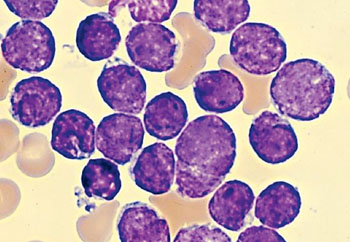Genetic Cause of Increased Leukemia Risk Identified
By LabMedica International staff writers
Posted on 13 Apr 2015
A newly discovered heritable genetic cause of acute lymphoblastic leukemia (ALL), has been pinpointed, specifically a mutation of the oncogene that encodes an E26 transformation-specific factor (ETS). Posted on 13 Apr 2015
Insight of the gene mutation may help doctors to increase monitoring and to develop strategies to prevent the disease as there are around 30,000 cases of ALL diagnosed in the USA each year, with a majority of cases in children aged two to five years.

Image: Bone marrow aspirate from a child with acute lymphoblastic leukemia shows sheets of blasts which have very scant cytoplasm and nuclei with finely dispersed, dense chromatin without nucleoli, typical appearance of lymphoblasts (Photo courtesy of the Autonomous University of Zacatecas).
A large team of international scientists led by those at University of Colorado Cancer Center (Aurora, CO, USA) identified a family with autosomal dominant thrombocytopenia, high erythrocyte mean corpuscular volume (MCV) and two occurrences of B cell–precursor acute lymphoblastic leukemia (ALL). Whole-exome sequencing identified a heterozygous single-nucleotide change in ets variant 6 (ETV6), c.641C>T, encoding a p.Pro214Leu substitution in the central domain, segregating with thrombocytopenia and elevated MCV. A screen of 23 families with similar phenotypes identified two with ETV6 mutations.
One family also had a mutation encoding p.Pro214Leu and one individual with ALL. The other family had a c.1252A>G transition producing a p.Arg418Gly substitution in the DNA-binding domain, with alternative splicing and exon skipping. Functional characterization of these mutations showed aberrant cellular localization of mutant and endogenous ETV6, decreased transcriptional repression and altered megakaryocyte maturation.
The ETV6 gene provides instructions for producing a protein that functions as a transcription factor, which means that it binds to specific regions of DNA and controls the activity of certain genes. ETV6 is involved in the development of blood cells. Dissimilar to somatic mutation of the ETV6 gene, a germline mutation places a patient one step closer to the development of leukemia from birth.
Christopher C. Porter, MD, an associate professor in the Department of Pediatrics and a senior study author said, “These people are born with a broken gene and it sets them up for leukemia. It's not common in a general population, but we think it might be much more common in people who develop ALL. This study highlights this gene in the development of leukemia. By studying this mutation, we should be able to gather a better understanding of how leukemia develops.” The study was published on March 25, 2015, in the journal Nature Genetics.
Related Links:
University of Colorado Cancer Center













